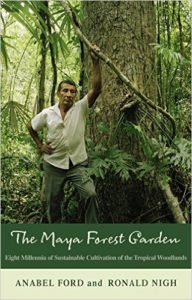The Maya Forest Garden: Eight Millennia of Sustainable Cultivation of the Tropical Woodlands
 by Anabel Ford and Ronald Nigh
by Anabel Ford and Ronald Nigh
It is a common belief that the ancient Maya disappeared and their population became too large to be supported with the known traditional farming practices. In their new book, The Maya Forest Garden, Ford and Nigh respond to this and many of today’s misconceptions about the Maya civilization. They propose that the Maya balanced elite demands with good resource stewardship. Drawing on ethnography, archaeology, paleoecology, botany, agroforestry, geography, conservation and more, they ask why is the Maya forest a garden today where all the dominant trees are useful? Presenting years of interdisciplinary research, they show that the milpa cycle of the contemporary Maya fits with the archaeological settlements. Their alternative paradigm links the Maya present to past and has captivated scholars, permaculturalists, and the avocational archaeologist.
To purchase The Maya Forest Garden, visit Routledge, Amazon, or Barnes and Nobles.
Book Reviews:
The UCSB Current
“A groundbreaking new book co-authored by a UC Santa Barbara researcher, however, asserts the Maya not only survived their presumed apocalypse, they thrive today using farming techniques that are thousands of years old. “The Maya Forest Garden: Eight Millennia of Sustainable Cultivation of the Tropical Woodlands” (Left Coast Press, 2015) by UCSB’s Anabel Ford and Ronald Nigh demonstrates that the Maya milpa system is sustainable, sophisticated and highly productive. Nigh is a professor of social anthropology at Centro Investigaciones y Estudios Superiores in Chiapas, Mexico.” They argue instead that any “collapse” was political. Their analysis concludes that Maya forest gardens could and did support dense populations and that the inventory of their species makeup reveals centuries of continuous human management. Ford and Nigh bring decades of field research to this book and draw on ethnography, agroecology, ethno- and paleobotany, archaeology, historical climate data, and ethnohistory. Even today, Maya forest gardeners cultivate sustainably but are threatened by Euro-informed models of agriculture that view tropical lowlands as suitable mainly for destructive pasturing. Scholars interested in tropical swiddeners and Mesoamericans in particular should read this discussion.
–A. E. Adams, Central Connecticut State University
Choice Connect
“Ford (Univ. of California, Santa Barbara) and Nigh (Centro Investigaciones y Estudios Superiores, Chiapas) propose an expanded model of milpa agriculture founded in Maya agroforesty, in which the Maya, yesterday and today, manage all stages of the famous swidden cycle (including the allegedly fallow stages) and transform, cultivate, enhance, and exploit a diverse woodland—a Maya forest garden—of species useful for subsistence and trade. The authors refute the “myth of the milpa,” the narrative that the ancient Maya collapsed in population and cultural vigor because they overreached the limits of environmental sustainability with a milpa agriculture that destroyed soils and deforested landscapes.” Read more…
Friends of the Trees
“An excellent contribution to the world literature on sustainable, indigenous land management. After rigorous paleo-botanical, archaeological and ecological research and on the ground consultation with existing practitioners, the authors conclude that the widely assumed cause of the collapse of the Mayan civilization due to deforestation and environmental degradation is not true. The forest gardens developed by the Mayans were sustainable.” Read more…
Noozhawk
A groundbreaking new book co-authored by a UC Santa Barbara researcher, however, asserts the Maya not only survived their presumed apocalypse but they thrive today using farming techniques that are thousands of years old. Read more…
Inlandia Literary Journeys
“Ford’s book, “The Maya Forest Garden: Eight Millennia of Sustainable Cultivation of the Tropical Woodlands,” co-authored with Ronald Nigh, a professor at the Centro Investigaciones y Estudios Superiores en Antropología Social in Chiapas, Mexico, published in June, is the result of 44 years of excavation and research into El Pilar’sdomestic architecture, gardens and traditional forest crops.
“I set out to answer fundamental questions,” Ford said. “How did the Maya successfully establish a flourishing civilization in the Mesoamerican tropics? Would their strategies for survival be an alternative for us today?”” Read more…
Anthropology News
“The Maya Forest Garden is an impressive book on environmental and human history in the Maya area. I dare say it also constitutes a much-awaited response to the contagious yet uninformed apocalyptic notion of a ‘Maya collapse.'” Read more…
Resilience
“We have been reading The Maya Forest Garden by Anabel Ford and Ronald Nigh. It tells the tale of a civilization that weathered many climate changes, foreign conquests and failed attempts at cultural genocide. That civilization is still there today, after 8,000 years.” Read more…
Popular Archaeology
For years, archaeologist Anabel Ford has been arguing the case that the ancient Maya knew well how to manage their tropical forest environment to their advantage, eventually sustaining large populations even beyond the time when many archaeologists suggest the Maya declined and abandoned their iconic Classic period pyramidal and temple constructions and monumental inscriptions during the 8th and 9th centuries CE. She challenges the popular theories long held by many scholars that the Maya declined because of overpopulation and deforestation from increased agricultural production, perhaps aggravated by draught and climate change.”Read more…
Alai
“Anabel Ford (Universidad de California-Santa Bárbara) y Ronald Nigh (Centro de Investigaciones y Estudios Superiores en Antropología Social-Sureste) vienen de publicar el libro “El jardín forestal maya: ocho milenios de agricultura sustentable en las selvas tropicales bajas[1]”. Dicha investigación aporta una hipótesis alternativa que desenmascara el supuesto colapso ambiental causado por la cultura maya en el periodo clásico.” Read more…
Independent
“In 2001, I traveled to the Belize-Guatemala border to report on UCSB archaeologist Anabel Ford’s many discoveries at El Pilar, the Maya monument complex she uncovered in 1983. That’s where she developed revolutionary theories that threatened to rock the academic world, namely that the Maya did not “disappear” due to an overpopulation cataclysm, but merely dwindled with time.”Read more…
For more information about author Anabel Ford, visit her websites:
www.marc.ucsb.edu
exploringsolutionspast.org
www.amazon.com/Anabel-Ford/e/B001KCA0BQ